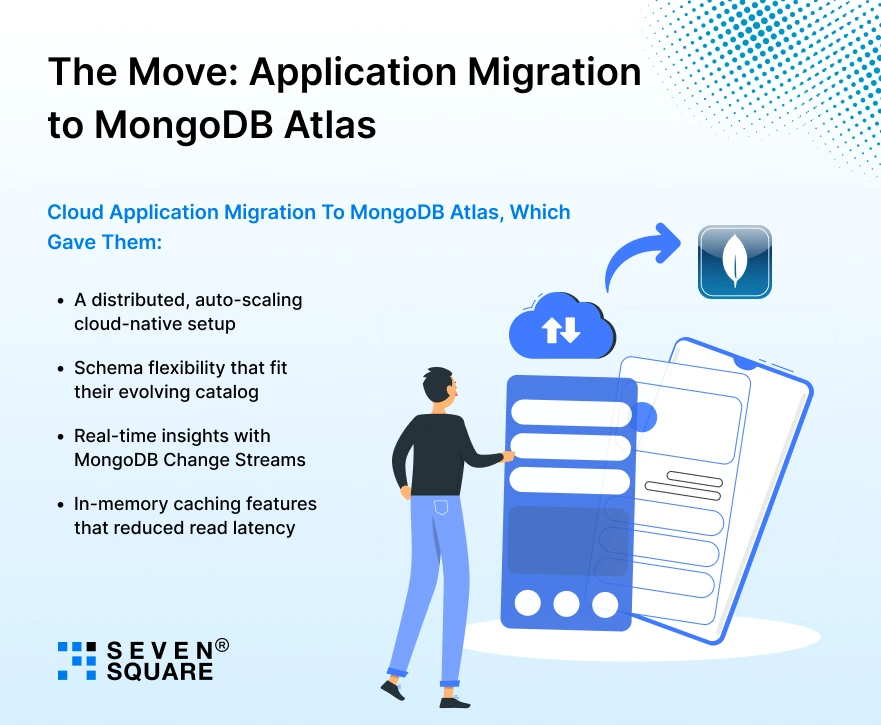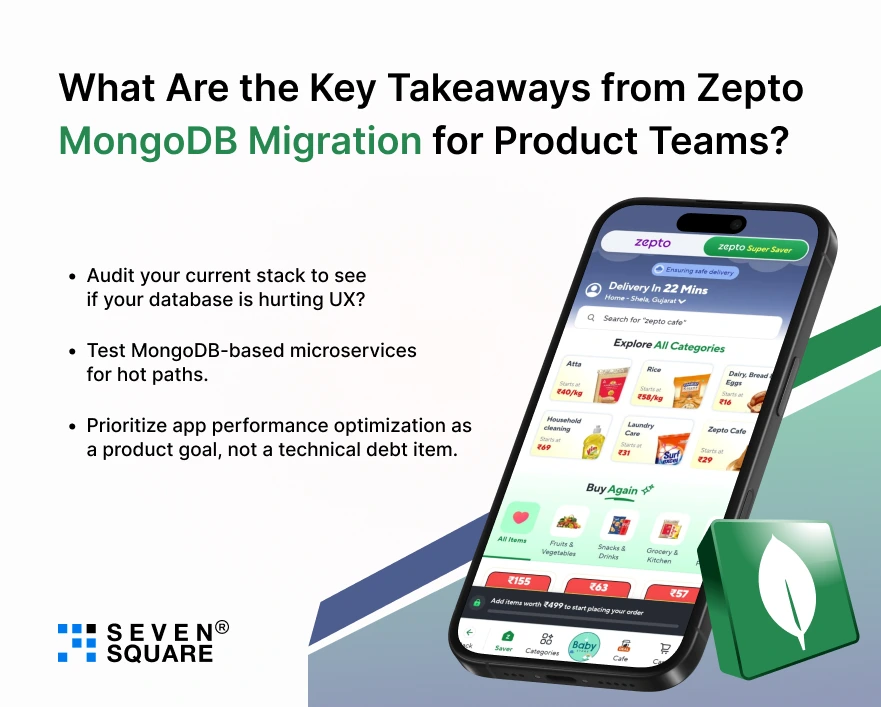Imagine this: It’s a peak hour. Your users are hungry. Orders pour in.
But your app, your backend starts to lag. Response times spike. Customers churn. Riders get delayed. You lose revenue in seconds.
We’ve seen this scenario too often at Seven Square. Founders come to us after hitting this exact wall. And that’s what makes the Zepto MongoDB migration move become so relevant right now.
Zepto is a fast-scaling quick commerce platform promising 10-minute grocery delivery who faced this exact challenge.
Their initial setup worked until it didn’t. Built on PostgreSQL, their system started crumbling under load. Latency increased. Joins became painful. And scaling became a slow, expensive process.
What did they do? They decided to go for MongoDB Atlas migration. The result? A 40% reduction in latency and a database stack that finally scaled with their ambition.
We’ve helped businesses across fintech, media, and logistics to design scalable platforms using smart architecture decisions.
We believe in speed, clarity, and quality. And this is what Zepto got right.
What Went Wrong With PostgreSQL?
Relational databases like PostgreSQL are battle-tested. But they’re not built for:
- Fast-evolving data models
- High-frequency writes at scale
- Real-time location tracking
- Modern on-demand app workloads
Zepto’s app performance optimization efforts kept hitting a ceiling.
Their response times at the 95th percentile became unacceptable, and scaling read/write throughput needed hacky workarounds.
If you’re building a similar app then it’s crucial to understand when traditional stacks become bottlenecks.
The Move: Application Migration to MongoDB Atlas

Instead of patching their PostgreSQL setup, Zepto opted for a smarter path of application migration.
More specifically, cloud application migration to MongoDB Atlas, which gave them:
- A distributed, auto-scaling cloud-native setup
- Schema flexibility that fit their evolving catalog
- Real-time insights with MongoDB Change Streams
- In-memory caching features that reduced read latency
This wasn’t just a tech switch. It was a system migration process built for scale. And that’s the kind of transformation we help to achieve at Seven Square.
The Results: MongoDB Performance Optimization That Mattered
Here’s what happened post-migration:
- 40% drop in average API latency
- 38% improvement in tail-end performance
- Faster time-to-market for new features
This is MongoDB latency reduction in action. And it proves something we’ve believed for years:
“A fast, scalable backend is the foundation of every great on-demand app.”
Whether it’s ride-hailing, food delivery, or home services, performance sells.
Understand the mobile app development process and how you can have MongoDB as your cloud partner.
What Made MongoDB a Game-Changer?
We’ve used MongoDB in several projects at Seven Square. And here’s why it works so well for mobile app migration and app platform migration:
- Document-based data modeling fits user-centric apps
- Horizontal scaling without complex setups
- Inbuilt replication and failover for availability
- Cloud-native migration strategies for apps become easier with Atlas
Zepto’s engineers didn’t just switch tech, they rethought their architecture.
Zepto MongoDB migration is the biggest example that cloud migration is possible & help to scale your business.
They chose refactoring over rehosting and optimized for performance, not just compatibility.
How to Migrate Your App to a New Platform Without Breaking It?
We’ve led multiple application replatforming and legacy app modernization projects. And here’s the real challenge: migration isn’t just technical but it’s strategic.
A few things we advise every founder to consider:
- Steps for successful application migration include deep user-flow analysis.
- Decide between app refactoring vs rehosting based on business goals.
- Understand the cost of migrating apps to cloud platforms and what ROI looks like.
- Use the right tools for app platform migration, not just what’s popular.
- Build a fallback plan to avoid downtime during app migration.
If you’re serious about migrating legacy apps to modern platforms, you need a partner who understands the product, not just code. That’s what we do.
A Checklist for Founders Planning App Migration
Here’s a field-tested application migration checklist for developers and founders:
- Identify your latency-sensitive endpoints
- Profile current database performance and query load
- Prototype on MongoDB for one high-volume use case
- Evaluate MongoDB vs PostgreSQL performance for that module
- Plan a staged rollout
- Monitor using Atlas and APM tools
Migration isn’t about replacing tech. It’s about redesigning for outcomes. That’s what helps you build profitable, reliable apps.
What Are the Key Takeaways from Zepto MongoDB Migration for Product Teams?

What can you actually do with these insights? Here are three actions you can take:
1. Audit your current stack to see if your database is hurting UX?
2. Test MongoDB-based microservices for hot paths.
3. Prioritize app performance optimization as a product goal, not a technical debt item.
Even if you’re not ready to migrate your full app, building one isolated module with MongoDB can help validate the gains.
How Seven Square Helps Founders Build Scalable Backends That Actually Perform?
Whether it’s reducing app latency, managing complex data flows, or rethinking your backend architecture.
We have a team who specializes in solving real-world performance problems that growing platforms face.
We’ve been the backend force behind some of the most demanding digital products.
1. Wisden: Real-time Cricket Data, Delivered at Scale
- When Wisden, a globally recognized name in cricket journalism, needed a high-performance digital platform to handle live scores, articles, and player analytics, we re-architected their backend to ensure low-latency content delivery even during peak matches.
- Our scalable API-first backend allowed their editorial and data teams to move fast without tech bottlenecks.
2. SVSBL: A Secure Banking Platform Built for Trust
- For SVSBL, a secure digital banking experience wasn’t just a feature it was the foundation.
- We helped design and implement a robust backend infrastructure with advanced role-based access control, encrypted data layers, and scalable APIs.
- The result? A smooth, secure platform that supports customer onboarding, transaction management, and account security all without downtime.
We’ve seen firsthand how application migration to new platform strategies can unlock product speed, not just stability.
And if there’s one thing we consistently recommend, it’s this:
“Don’t wait for users to complain about speed. Anticipate the bottlenecks.”
Swift delivery, clear communication, and zero compromise on quality that’s how we approach every app migration. Our work blends engineering with business impact.
Ready to make the switch? Let’s talk!
Don’t Just Copy Zepto But Learn From Them
Zepto didn’t switch to MongoDB because it was trendy. They did it because it solved their latency problem for real. And that’s the kind of decision every founder will face eventually.
If your app’s backend is slowing down growth, now’s the time to rethink. Whether it’s a mobile app migration, cross-platform app development, or full-stack cloud migration services, the decisions you make now shape your product’s future.
Let Zepto’s journey be your signal but not your blueprint.
Because the best architecture is the one that keeps your business moving forward.
FAQs
- Zepto made the switch to MongoDB to reduce latency and improve scalability for its growing on-demand delivery operations.
- Relational databases like PostgreSQL couldn’t handle the high velocity of data ingestion and real-time processing required for their expanding user base.
- Zepto experienced a 40% reduction in latency, faster query performance, and easier schema flexibility.
- MongoDB’s document-based model allowed their backend to scale quickly without constant database redesigns.
- MongoDB uses a flexible document model and in-memory processing (with WiredTiger engine) that reduces query time significantly.
- By eliminating complex joins and flattening data access, it helps high-traffic apps deliver faster responses.
- Yes. MongoDB is ideal for real-time apps due to its scalability, horizontal sharding, and fast write-read performance.
- It works well for logistics, delivery, and marketplace platforms where data updates are frequent.
- Yes, MongoDB’s schema-less structure makes it easy to manage dynamic data types like orders, locations, users, and status updates without constant database migrations which is perfect for on-demand services.